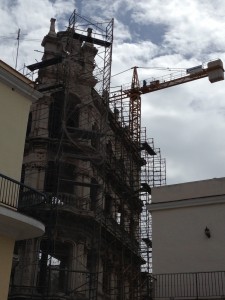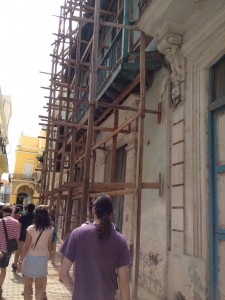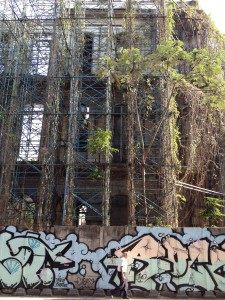Construction in Cuba
May 3, 2012 by emburke
On the morning of our first day in Cuba we gathered together in Old Havana to take a guided walking tour through the city’s historical center. Our guide opened proudly with a statement that we were standing in the middle of one of an area that the government had recently restored. It was one of the first parts of the city we were exposed to and the area, while nice, seemed to be at a relatively normal level of structural upkeep. It wasn’t until our group moved through an intersection and into a part of the neighborhood that lacked tourist attractions that I understood the stunning contrast between the restored and un-restored sections of Havana. Everything from the condition of the roads to the buildings themselves changed. Like many things in Cuba, while just enough had been done to create a positive impression on tourists, as soon as we exited the sphere specifically devoted to tourist activity it was like looking at a different country. Having been awoken to the stark contrast between tourist and citizen architectural conditions early on, I found myself looking for evidence of restorative construction in Cuba for the rest of our trip. I learned quickly that I would need to do a whole lot of searching before much construction on the crumbling and falling buildings of Cuba was found.
 With my quest for evidence of construction under way, I began to take note of scaffolding all around Cuba. While I saw a few instances of scaffolding that seemed to be in place for construction purposes, for the most part construction was rarely seen around the falling buildings that are the homes of hundreds of thousands of Cubans. As we progressed through our travels I began to notice a great variety of types of scaffolding. While the kind of steel scaffolding that we are most accustomed to seeing in the US exists, particularly in more residential areas I began to notice a high frequency of scaffolding constructed from lumber. While I couldn’t be sure what the differences between scaffolding in Cuba meant, it awakened an interest in the state of construction in Cuba within me. Based on what I had observed firsthand, it seemed that even where scaffolding exists, it is only very rarely in place for the purpose of construction and more often a means of supporting buildings that may otherwise be in danger of collapse. For example, on one occasion I happened upon a building surrounded by scaffolding that had been erected for so long that vines had covered it. However, while I found myself making assumptions about the state of construction in Cuba based on what I saw around me, I was curious to get a better and more accurate understanding of the state of construction in Cuba.
With my quest for evidence of construction under way, I began to take note of scaffolding all around Cuba. While I saw a few instances of scaffolding that seemed to be in place for construction purposes, for the most part construction was rarely seen around the falling buildings that are the homes of hundreds of thousands of Cubans. As we progressed through our travels I began to notice a great variety of types of scaffolding. While the kind of steel scaffolding that we are most accustomed to seeing in the US exists, particularly in more residential areas I began to notice a high frequency of scaffolding constructed from lumber. While I couldn’t be sure what the differences between scaffolding in Cuba meant, it awakened an interest in the state of construction in Cuba within me. Based on what I had observed firsthand, it seemed that even where scaffolding exists, it is only very rarely in place for the purpose of construction and more often a means of supporting buildings that may otherwise be in danger of collapse. For example, on one occasion I happened upon a building surrounded by scaffolding that had been erected for so long that vines had covered it. However, while I found myself making assumptions about the state of construction in Cuba based on what I saw around me, I was curious to get a better and more accurate understanding of the state of construction in Cuba.
 An article in the Havana Journal discusses the Cuban effort to decentralize construction projects, largely as a result of a failure on the part of the national government to attain the knowledge needed to accurately indentify how the limited construction materials in Cuba could be best put to use region by region. After launching a major effort to solve the chronic housing shortage and repair crumbling buildings in Cuba in 2005, the construction industry continued to fall short of meeting goals. Beginning in 2009 the state turned to a new approach of a more decentralized construction industry. Vice President Carlos Lage explains, “The local authorities must say what they prefer to do with the resources assigned them, be it finishing new apartments or prioritizing the repair of others, because it is at the municipal level that authorities know best an area’s urgent needs”. Additionally, beginning in the 1990s Cuba began granting licenses to privately engage in building trades. This has resulted in conditions in which, while the state construction business has a chronic labor shortage, thousands of licensed and unlicensed skilled tradesmen and laborers work privately. Thus, it seems that just as so many other Cuban industries have undergone similar reforms and begun to operate in a dual system, split between state and private operation, the construction industry is no different.
An article in the Havana Journal discusses the Cuban effort to decentralize construction projects, largely as a result of a failure on the part of the national government to attain the knowledge needed to accurately indentify how the limited construction materials in Cuba could be best put to use region by region. After launching a major effort to solve the chronic housing shortage and repair crumbling buildings in Cuba in 2005, the construction industry continued to fall short of meeting goals. Beginning in 2009 the state turned to a new approach of a more decentralized construction industry. Vice President Carlos Lage explains, “The local authorities must say what they prefer to do with the resources assigned them, be it finishing new apartments or prioritizing the repair of others, because it is at the municipal level that authorities know best an area’s urgent needs”. Additionally, beginning in the 1990s Cuba began granting licenses to privately engage in building trades. This has resulted in conditions in which, while the state construction business has a chronic labor shortage, thousands of licensed and unlicensed skilled tradesmen and laborers work privately. Thus, it seems that just as so many other Cuban industries have undergone similar reforms and begun to operate in a dual system, split between state and private operation, the construction industry is no different.
 While it is clear from visiting Cuba that the nation continues to face serious challenges in the form of architectural maintenance, it is difficult to pinpoint the exact point in which the Cuban approach begins to fail. The problematic nature of construction in Cuba is complicated by a difficulty in attaining construction materials, in addition to the issues that are presented by the split construction industry. It seems that once again Cuba has been caught between a struggle to provide for the nation’s population, while it also works to maintain spaces of tourism so the nation’s international reputation is not put in jeopardy by visiting tourists. In many ways, the construction predicament Cuba finds itself in is representative of a much larger theme in Cuba. With the nation’s continued reliance on tourism there is significant pressure for Cuba to maintain the spaces of tourism in a way that are aesthetically pleasing and presentable. However, it seems that by ensuring the maintenance of these spaces Cuba has had to sacrifice structural soundness of buildings inhabited by Cuban citizens. As Cuba continues to struggle to ameliorate living conditions, one has to wonder just how much longer Cuba can afford to sacrifice the health and safety of its citizens for the opinions of foreign visitors.
While it is clear from visiting Cuba that the nation continues to face serious challenges in the form of architectural maintenance, it is difficult to pinpoint the exact point in which the Cuban approach begins to fail. The problematic nature of construction in Cuba is complicated by a difficulty in attaining construction materials, in addition to the issues that are presented by the split construction industry. It seems that once again Cuba has been caught between a struggle to provide for the nation’s population, while it also works to maintain spaces of tourism so the nation’s international reputation is not put in jeopardy by visiting tourists. In many ways, the construction predicament Cuba finds itself in is representative of a much larger theme in Cuba. With the nation’s continued reliance on tourism there is significant pressure for Cuba to maintain the spaces of tourism in a way that are aesthetically pleasing and presentable. However, it seems that by ensuring the maintenance of these spaces Cuba has had to sacrifice structural soundness of buildings inhabited by Cuban citizens. As Cuba continues to struggle to ameliorate living conditions, one has to wonder just how much longer Cuba can afford to sacrifice the health and safety of its citizens for the opinions of foreign visitors.
38 Responses to “Construction in Cuba”
Leave a Reply
You must be logged in to post a comment.
barc recruitment 2018
mejor champu para hombre
https://ferrann.com
que es el shampoo
https://ferrann.com/
mejor shampoo para alopecia
como utilizar el shampoo azul
tratamientos caida pelo
https://ferrann.mx/alopecia/
https://ferrann.co/blog/shampoo-para-cabello-graso/
blog topic
https://ferrann.com/blog/errores-elegir-shampoo-para-el-cabello-graso/
ferrann.co
productos para la caida del cabello
https://ferrann.mx
https://ferrann.com/blog/tratamientos-para-la-alopecia-en-mujeres/
https://ferrann.mx/blog/cabello-graso-descubre-controlarlo
tratamiento para la calvicie
porque se me cae el cabello
ferrann.mx
https://ferrann.com/blog/shampoo-para-cabello-graso/
https://ferrann.com/blog/productos-para-la-caida-del-cabello/
https://ferrann.com/blog/remedios-caseros-para-la-caida-del-cabello/
https://ferrann.mx/blog/tipos-de-productos-para-hidratar-el-cabello/
si dejo de usar minoxidil se me cae el pelo
linaza para el cabello
https://ferrann.com/blog/tratamiento-para-cabello-seco-el-infalible/
https://ferrann.com/blog/tratamiento-para-la-caida-del-cabello-en-hombres/
https://ferrann.com/blog/como-reparar-el-cabello-seco/
https://ferrann.com/blog/shampoo-de-placenta/
https://ferrann.com/blog/como-evitar-la-caida-del-cabello-en-los-hombres/
https://ferrann.com/blog/mascarilla-de-huevo-para-el-cabello-maltratado/
https://ferrann.mx/blog/mascarilla-de-huevo-para-el-cabello-maltratado/
ferrann.mx
https://ferrann.com/blog/shampoo-crece/
https://ferrann.mx/blog/shampoo-con-biotina/
https://ferrann.com/blog/remedios-para-la-caida-del-cabello/
https://ferrann.com/blog/evita-la-caida-del-pelo-poco-tiempo/
globalsuccessvn.Com
» Construction in Cuba CUBAN TRANSITIONS